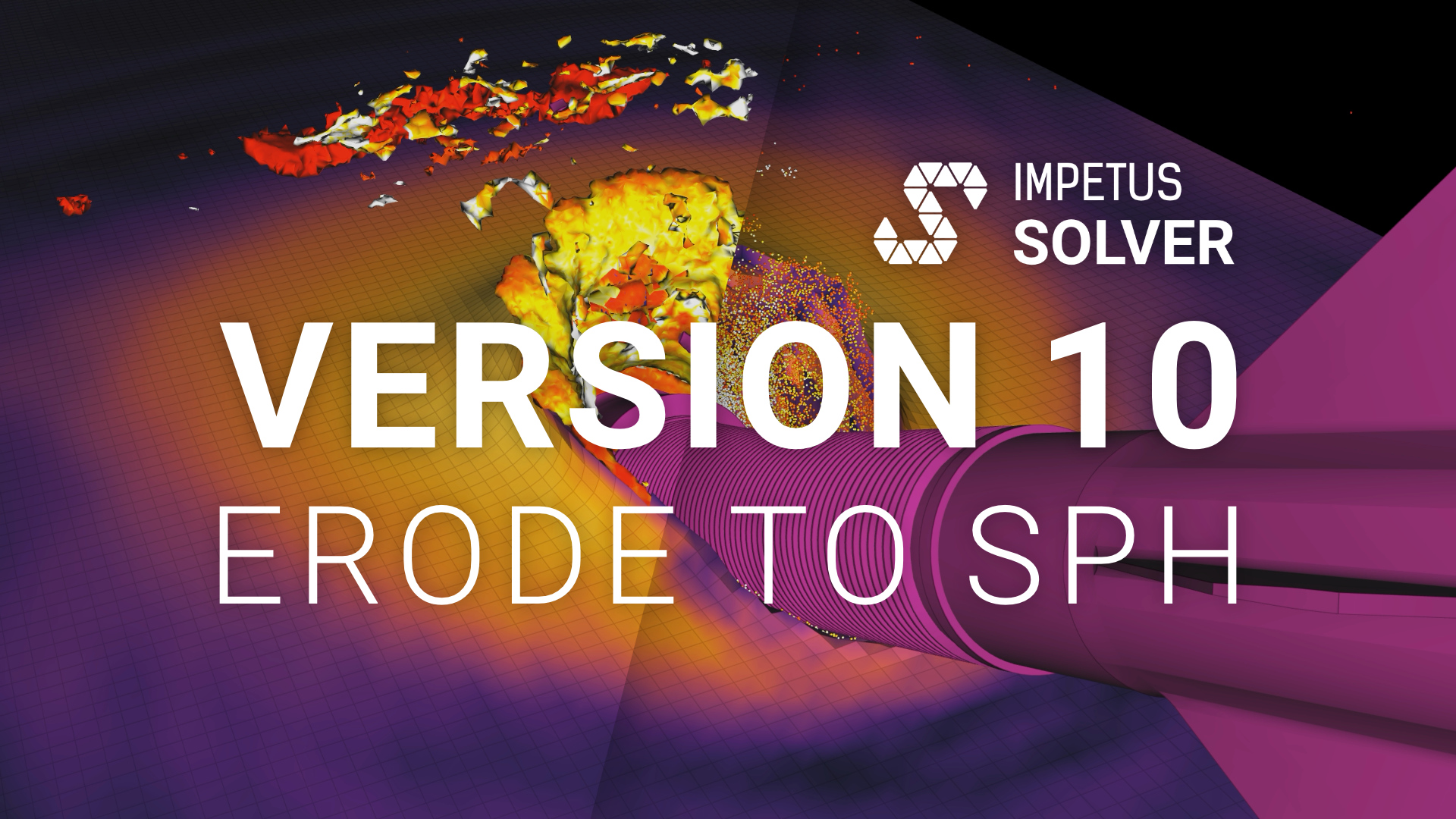Impetus Solver version 10 introduces an important technical novelty with significant implications for the modelling of several applications and processes. The novelty is the automatic conversion of eroding finite elements to SPH particles. We term this new technique Erode-to-SPH (E2S). This method ensures that mass and confinement is preserved in cases where elements are so highly distorted that they must be eroded. This is critically important for accurate predictions in terminal ballistics in thick targets.
Dynamic conversion of eroded elements
The conversion from FE to SPH is done dynamically whenever elements are eroded and does not have to be pre-assigned before the simulation starts. It can be difficult to predict a priori where this is needed, for instance in the case of ricochet. This has very important modelling implications, as it allows modelling the geometry with relatively large elements and early erosion criteria. The element erosion to SPH particles thus functions as a local dynamic refinement. This allows for the handling of larger structures with more modest memory and hardware requirements than what is possible with traditional modelling techniques.
The number of SPH particles replacing a single finite element (the E2S factor) can be configured by the user. As a rule of thumb, aiming for eroding one element to roughly 100 particles typically yields good results.
When an element is eroded and converted to SPH, the particles that are located on the interface are merged with the remaining elements. In this way the material still behaves as a Lagrangian continuum, even if modelled with two distinct numerical techniques.
The SPH particles take part in the contact calculations. Given a sufficiently high E2S factor, there will be a smooth transition in contact forces instead of the dreaded numerical hammering effect that may occur when elements erode. This is a numerical effect that cause abrupt jumps in contact forces, degrading the accuracy and predictive capability of the simulation. The smooth transition to SPH particles solves this long-standing numerical problem, yielding better results.
Contrast with classical erosion methods
This is in stark contrast to the classical element erosion, “Erode-to-Void“, where elements are simply removed from the simulation, with a resulting loss of mass and confinement. This makes crack propagation modelling difficult without exceedingly high element counts. Also, compared with our node splitting technique, cracks are no longer restricted to follow element boundaries. Depending on the E2S factor, the degrees of freedom for crack propagation increases by orders of magnitude with just a modest increase of memory requirements. This opens for new research opportunities and we invite the research community to start exploring this.
Material models compatibility
All our material models have been implemented for finite elements, and many have now also been implemented for SPH. This includes *MAT_METAL, *MAT_HSS and now in version 10 also *MAT_MM_CONCRETE. In these cases, all material state variables (stresses and strains) are mapped between the eroding element and the spawned SPH particles. The material will thus behave in the same way after the transition.
Some of the more advanced material models have not been ported to SPH. This includes *MAT_FABRIC and *MAT_CERAMIC. In such cases a simpler material model like *MAT_METAL must be assigned to the SPH sub-domain. For a composite target, delamination will only be handled with FE, while conservation of mass and fragmentation can be handled after transition with a simpler material model.
Fragmentation across FE and SPH domains
As interface particles and elements are merged, fragmentation works across FE and SPH domains. Even with a coarse mesh, realistic fragments can be generated by the local dynamic refinement, possibly consisting of a mix of finite elements and SPH particles. As each element is replaced by a large number of SPH particles, the method allows for fragment distributions including very small fragments that are smaller than the smallest finite element.
Enabling E2S
Activating E2S requires defining a particle domain and one SPH sub-domain for each of the relevant FE parts. Setting the E2S flag in the *PARTICLE_SPH command is all that is required to activate automatic conversion. In the knowledge base you can find a small tutorial on how to activate Erode-to-SPH (E2S) functionality.
Application examples and case studies
This novel modelling technique can be used in several applications and processes. Large, complex targets can be modelled with finite elements and impacted with shaped charge jets. The local dynamic refinement ensures good interaction between the SC jet and the target with high computational speed and limited memory requirements. Instead of modelling everything in SPH with a gigantic number of particles, potentially requiring a cluster of GPUs, such a simulation is now feasible with a single GPU.
Similarly, an entire vehicle, modelled with coarse finite elements, can be impacted by a long rod arrow projectile from different directions and impact angles. The local dynamic refinement again ensures that details are high when needed, but within the memory requirements of a single high-end GPU. And no manual labor is required for refining for different directions.
The same applies to concrete targets where concrete material model is implemented for both FE and SPH, ensuring consistency between the numerical domains.
We envision that this modelling technique will find more use cases as Impetus Solver version 10 is adopted by the industry. It is an important new tool that might require rethinking what is possible to simulate. Start with a coarse finite element mesh, refine to SPH locally when needed and solve larger and more complex problems than you first thought possible.
Upcoming webinar
We will host a webinar on Erode-to-SPH on October 15 2025 at 10:00 CEST. Lars Olovsson, CTO of IMPETUS, will introduce the technique, how it works, give practical guidance on how to use it and show examples where it is used. Make sure you don’t miss it.




